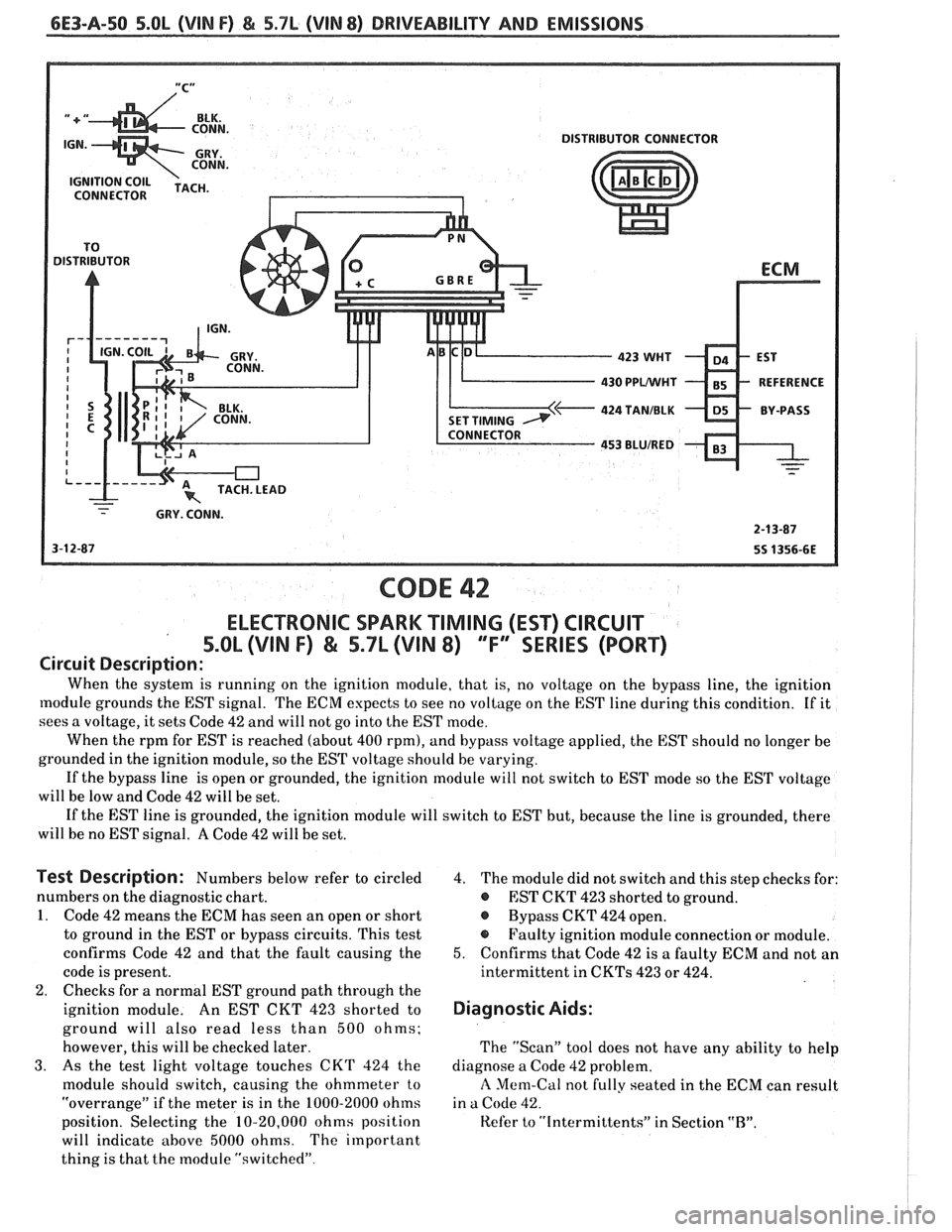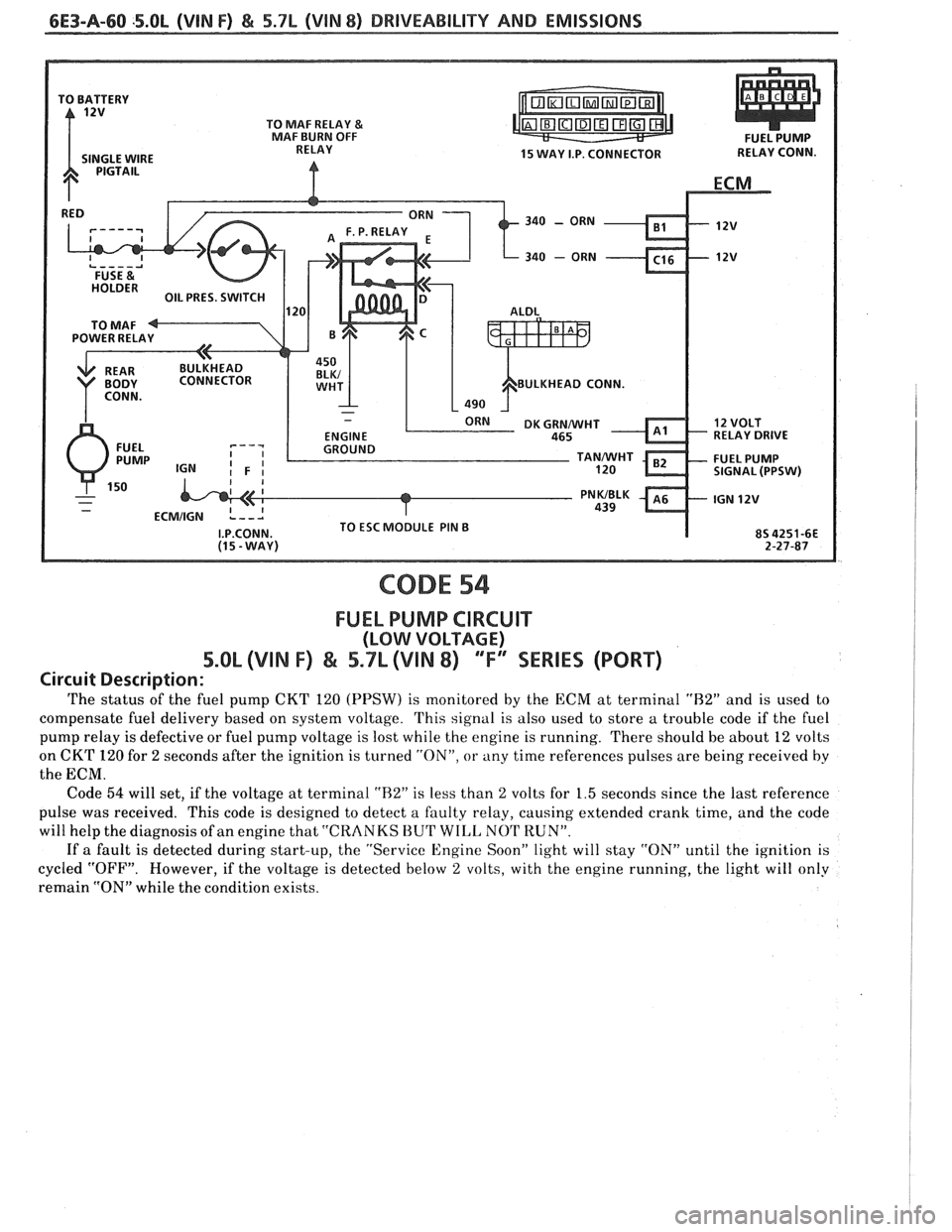Page 849 of 1825

6E3-A-46 5.Ob (VIN F) & 5.7b (VIN 8) DRIVEABILITY AND EMISSIONS
SYSTEM GND
SYSTEM GND
SYSTEM GND
CODE 36
MASS AIR FLOW (MAF) BURN-OFF CIRCUIT
5.Qh (VlN F) & 5.7L (VIN 8) ""F9SERlES (PORT)
Circuit Description:
The mass air flow (MAF) sensor measures the amount of air which passes through it. The ECM uses this
information to determine the operating condition of the engine, to control fuel delivery. For
a detailed
description of the MAF sensor operation see Section
"C".
Due to contaminates in the atmosphere, a residue may build up on the MAF sensor sensing wire. To
maintain an accurate reading from the sensor, a "burn-off' cycle will occur when the ignition is turned "OFF"
after the engine had been running a specified amount of time and engine warmed up. The burn-off function is
enabled when the ECM grounds
CKT 900 which energizes the MAF sensor burn-off relay. With the MAF sensor
burn-off relay energized, voltage will be supplied to the MAF sensor terminal
"D". Voltage will also be supplied
through the normally closed set of contacts in the MAF power relay which will supply 12 volts to terminal
"E" of
the MAF sensor.
Test Description: Numbers below refer to circled
numbers on the diagnostic chart.
1. This test will determine if the burn-off function is
operative or if the Code was set due to an
intermittent condition.
2. Check for continuous 12 volt supply to burn-off
relay.
3. Grounding CKT 900 should energize the relay and
close the contacts. CKT 900 should be grounded
by using a jumper wire at ECM connector
"D12".
If the test light is dim, check for corroded or faulty
connections. If OK, replace relay.
3. With the burn-off relay energized there should be
12 volts supplied to the MAF sensor on terminal
"1)" & "E:" (CK'I's 993 and 994). If the test light is
dim, check for corroded or faulty connections. If
OK, replace relay.
Diagnostic Aids:
The Code 36 could have been set due to a poor
connection at
any of the relays or the MAF sensor. Be
sure that these connections and terminals are OK.
A
faulty MAF sensor should not be considered as the
cause
if Code 36 is set.
Refer
to "intermittents" in Section "R".
Page 853 of 1825

6E3-A-50 5.OL (VIN F) & 5.7L (VIN 8) DRI\/EABILITY AND EMISSIONS
430 PPUWHT
424 TANIBLK
CODE 42
ELECTRONIC SPARK "TIMING (EST) CIRCUIT
5.011, (VIN F) & 5.7L (VIN 8) ""FYESERIES (PORT)
Circuit Description:
When the system is running on the ignition module, that is, no voltage on the bypass line, the ignition
[nodule grounds the EST signal. The ECM expects to see no voltage on the EST line during this condition. If it
sees a voltage, it sets Code
42 and will not go into the EST mode.
When the rpm for EST is reached (about
400 rpm), and bypass voltage applied, the EST should no longer be
grounded in the ignition module, so the EST voltage should be varying.
If the bypass line is open or grounded, the ignition module will not switch to EST mode so the EST voltage
will be low and Code
42 will be set.
If the EST line is grounded, the ignition module will switch to EST but, because the line is grounded, there
will be no EST signal.
A Code 42 will be set.
Test Description: Numbers below refer to circled
numbers on the diagnostic chart.
1. Code 42 means the ECM has seen an open or short
to ground in the EST or bypass circuits. This test
confirms Code
42 and that the fault causing the
code is present.
2. Checks for a normal EST ground path through the
ignition module. An EST CKT
423 shorted to
ground will also read less than
500 ohms;
however, this will be checked later.
3. As the test light voltage touches CKT 324 the
module should switch, causing the ohmmeter
to
"overrange" if the meter is in the 1000-2000 ohms
position. Selecting the
10-20,000 ohms position
will indicate above
5000 ohms. The important
thing is that the module "switched"
4. The module did not switch and this step checks for:
@ EST CKT 423 shorted to ground.
@ Bypass CKT 424 open.
@ Faulty ignition module connection or module.
5. Confirms that Code 42 is a faulty ECM and not an
intermittent in
CKTs 423 or 424.
Diagnostic Aids:
The "Scan" tool does not have any ability to help
diagnose a Code
42 problem.
A Mem-Cal not fully seated in the ECM can result
in
a Code 42.
Kefer to "Intermittents" in Section "R".
Page 855 of 1825

6E3-A-52 5.OL (VIN F) & 5.7L (VIN 8) DRIVEABILITY AND EMISSIONS
CODE 43
ELECTRONIC SPARK CONTROL (ESC) ClRCUlT
5.OL (VIN F) & 5.7L (VIN 8) 'TF" SERIES (PORT)
Circuit Description:
Electronic spark control is accomplished with a module that sends a voltage signal to the ECM. As the
knock sensor detects engine knock, the voltage from the ESC module to the ECM drops, and this signals the
ECM to retard timing. The ECM will retard the timing when knock is detected and rpm is above about 900
rpm.
Code 43 means the ECM has been low voltage at CKT 485 terminal
"R7" for longer than 5 seconds, with the
engine running, or the system has failed the functional check.
This system performs a functional check once per start up to check the
ESC system. To perform this test the
ECM will advance the spark when coolant is above 95°C and at a high load condition (near
WOT). The ECM
then checks the signal at
"B7" to see if a knock is detected. The functional check is performed once per start up
and if knock is detected when coolant is below 95°C
(194°F') the test has passed and the functional check will not
be run. If the functional check fails, the "Service Engine Soon" light will remain
"ON" until ignition is turned
"OFF", or until a knock signal is detected.
Test Description: Numbers below refer to circled
numbers on the diagnostic chart.
1. If the conditions for a Code 43 are present, the
"Scan" will always display "yes". There should
not be a knock at idle unless an internal engine
problem, or
a system problem exists.
2. This test will determine if the system is
functioning at this time. Usually
a knock signal
can be generated by tapping on the right exhaust
manifold. If no knock signal is generated try
tapping on block close to the area of the sensor.
3. Because Code 43 sets when the signal voltage on
CKT 485 remains low, this test should cause the
signal on CKT 485 to go high. The
12 volts signal
should be seen by the ECM as "no knock" if the
ECM and wiring are OK.
4. This test will determine if the knock signal
is
being detected on CKT 496 or if the ESC module is
at fault. 5.
If CKT
496 is routed to close to secondary ignition
wires, the ESC module may see the interference as
a knock signal.
6. This checks the ground circuit to the module. An
open ground will cause the voltage on CKT 485 to
be about
12 volts, which would cause the Code 43
functional test to fail.
7. Contacting CKT 496 with a test light to 12 volts
should generate a knock signal. This will
determine if the ESC module is operating
correctly.
Diagnostic Aids:
Code 33 can be caused by a faulty connection at
the knock sensor at the ESC module or at the ECM.
Also check CKT 485 for possible open or short to
ground.
Refer to "Intermittents" in Section "R".
Page 856 of 1825
DRIVEABILITY AND EMISSIONS 5.OL (VIN F) & 5.7L (VIN 8) 6E3-A-53
ENGINE IDLING. LOCK
IN AREA OF KNOCK SENSOR.
PROBE HARNESS TERMINAL "C" (CKT GNAL
INDICATED WHILE TAPPING
485) WITH A TEST LIGHT CONNECTED
TO
12 VOLTS.
AFTER
5 SECONDS, DOES "SCAN"
r ENGINE IDLING.
@ MOMENTARILY TOUCH KNOCK
SENSOR HARNESS (CKT 496) WITH
A TEST LIGHT TO
12V. r EACH TIME THE TEST LIGHT
CONTACTS CKT
496, A KNOCK
SIGNAL SHOULD BE GENERATED.
Page 858 of 1825
DRIVEABILITY AND EMISSIONS 5.OL (VIN F) & 5.7L (VIN 8) 6E3-A-55
IF NO ADDITIONAL CODES WERE
SENSOR BETWEEN .35 VOLTS AND .55 VOLTS (350
STORED, REFER TO "DIAGNOSTIC
mV AND 550 mV).
CLEAR CODES AND CONFIRM "CLOSED LOOP" OPERATION AND NO "SERVICE ENGINE SOON" LIGHT.
Page 860 of 1825
DRIVEABILITY AND EMISSIONS 5.OL (VIN IF) & 5.7L (VIN 8) 6E3-A-57
HARNESS CKT412 TO GROUND. NO
ADDITIONAL CODES WERE
.35 VOLTS (350 mV).
CLEAR CODES ANDCONFIRM "CLOSED LOOP" OPERATION AND NO "SERVICE ENGINE SOON" LIGHT.
Page 863 of 1825

6E3-A-60 .5.0L (VIN F) & 5.7L (VIN 8) DRIVEABILITY AND EMISSIONS
340 - ORN
BULKHEAD CONN.
RELAY DRIVE
CODE 54
FUEL PUMP CIRCUIT
(LOW VOLTAGE)
5.OL (VIN F) & 5.7L (VIIN 8) "F" WRIES (PORT)
Circuit Description:
The status of the fuel pump CKT 120 (PPSW) is monitored by the ECM at terminal "H2" and is used to
compensate fuel delivery based on system voltage. This signal is also used to store a trouble code if the fuel
pump relay is defective or fuel pump voltage is lost while the engine is running. There should be about 12 volts
on CKT
120 for 2 seconds after the ignition is turned "ON", or any time references pulses are being received by
the ECM.
Code
54 will set, if the voltage at terminal "R2" is less than 2 volts for 1.5 seconds since the last reference
pulse was received. This code is designed to detect a faulty relay, causing extended crank time, and the code
will help the diagnosis of an engine that
"CRANKS BUT WILL NOT RUN".
If a fault is detected during start-up, the "Service Engine Soon" light will stay "ON" until the ignition is
cycled "OFF". However, if the voltage is detected below
2 volts, with the engine running, the light will only
remain "ON" while the condition exists.
Page 864 of 1825
DRIVEABILITY AND EMISSIONS 5.OL (VIN F) & 5.7L (VIN 8) 6E3-A-61
ONNECT FUEL PUMP
E LIGHT WITHIN 2
@ OIL PRESSURE NORMAL.